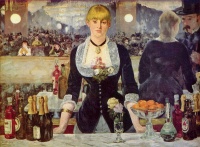Inn
From The Art and Popular Culture Encyclopedia

|
Related e |
|
Featured: |
Inns are generally establishments or buildings where travelers can seek lodging and, usually, food and drink. They are typically located in the country or along a highway.
History
Inns in Europe were possibly first established when the Romans built their system of Roman roads two millennia ago. Some inns in Europe are several centuries old. In addition to providing for the needs of travelers, inns traditionally acted as community gathering places.
Historically, inns in Europe provided not only food and lodging, but also stabling and fodder for the travelers' horses. Famous London examples of inns include the George and the Tabard. There is however no longer a formal distinction between an inn and other kinds of establishment. Many pubs use the name "inn", either because they are long established and may have been formerly coaching inns, or to summon up a particular kind of image.
During the 1800s the inn played a major role in the growing transportation system of England. Industry was on the rise and people were traveling more in order to keep and maintain business. The English Inn was considered an important part of English infrastructure as it helped maintain a smooth flow of travel throughout the country.
As modes of transport have evolved, tourist' lodging has adapted to serve each generation of traveller. A stagecoach made frequent stops at roadside coaching inns for water, food and horses. A passenger train stops only at designated stations in the city centre, around which were built grand railway hotels. Motorcar traffic on old-style two-lane highways may pause at any camp, cabin court or motel along the way, while freeway traffic is restricted to access from designated off-ramps to side roads which quickly become crowded with hotel chain operators.
The original functions of an inn are now usually split among separate establishments, such as hotels, lodges, and motels, all of which might provide the traditional functions of an inn but which focus more on lodging customers than on other services; public houses, which are primarily alcohol-serving establishments; and restaurants and taverns, which serve food and drink. (Hotels often contain restaurants serving full breakfasts and meals, thus providing all of the functions of traditional inns. Economy, limited service properties, however, claim at most an included continental breakfast as there is no kitchen and no bar.)
The lodging aspect of the word inn lives on in hotel brand names like Holiday Inn, and in some laws that refer to lodging operators as innkeepers. The Inns of Court in London were once accommodations for members of the legal profession.
See also

